If you want the most perfectly moist, flavorful, and juicy Thanksgiving Turkey, my dry brine turkey recipe is what you’re looking for. All you need to do is rub the turkey down with salt, seasonings, and fresh herbs. Then, place the turkey in the fridge and let the dry brine work its magic for the next 48 to 72 hours.
That’s all you need the prep you need to do, and you’re on your way to enjoying the best turkey you’ll ever eat!
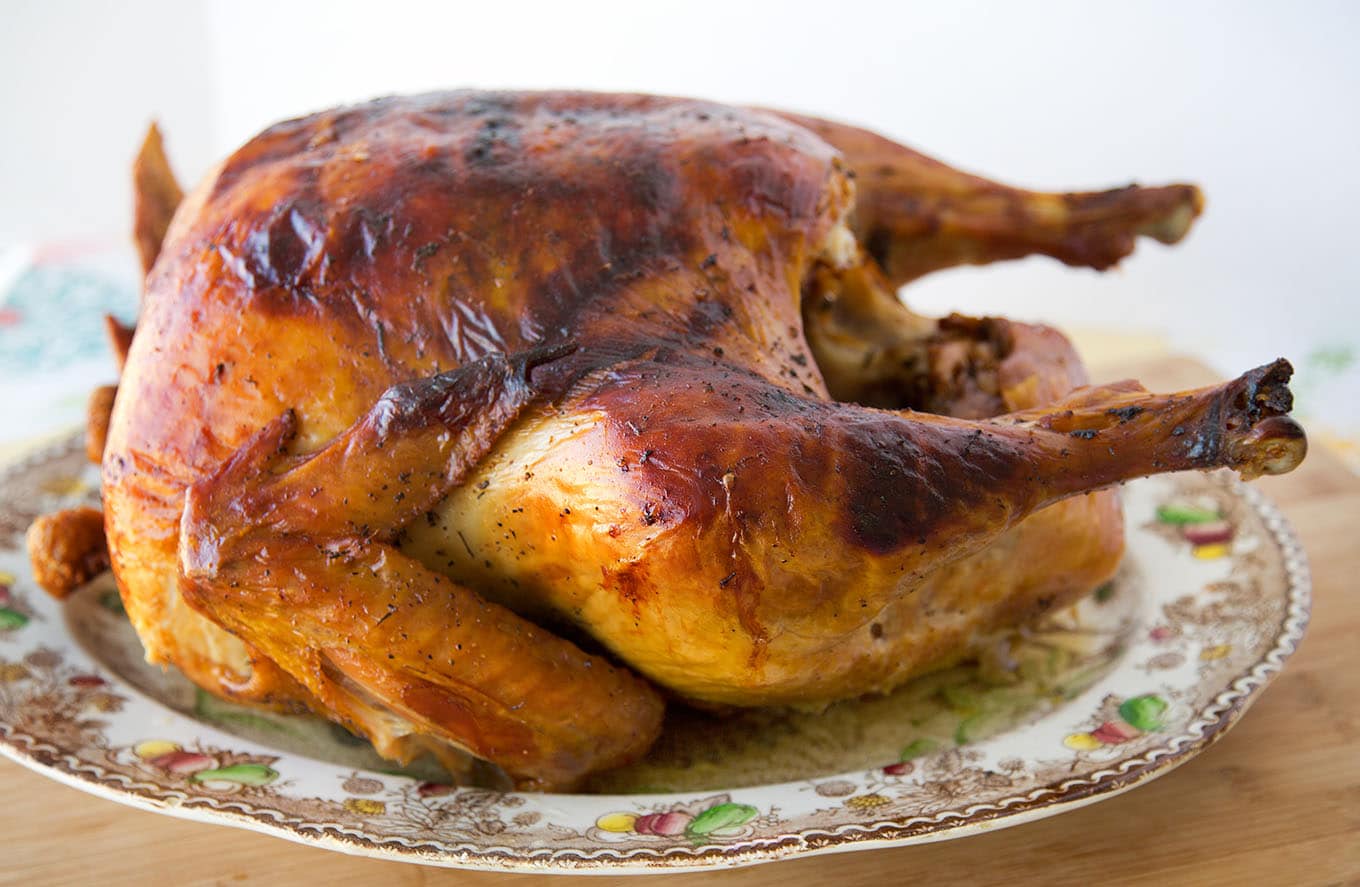
When it comes to cooking a turkey, what you do before it goes into your oven makes all the difference in the world.
Don’t be intimidated by the thought of cooking a turkey. Because I’m here to share my dry brining and roasting methods to make your holiday turkey the star of the holiday dinner
There are different thoughts on brining a turkey, with the choices being wet brine or dry brining. While both techniques will help you cook the most succulent turkey you’ve ever had, the smartest, easiest way to achieve the best results every time is with a dry brine.
It doesn’t matter if this is your first Thanksgiving dinner, my dry-brine method will make you look like a seasoned veteran of Thanksgiving and turn out an impeccably juicy, flavorful bird.
If you’re looking for a non-traditional dessert for the holidays, my Tiramisu will be the perfect ending to your holiday meal.
Ingredients
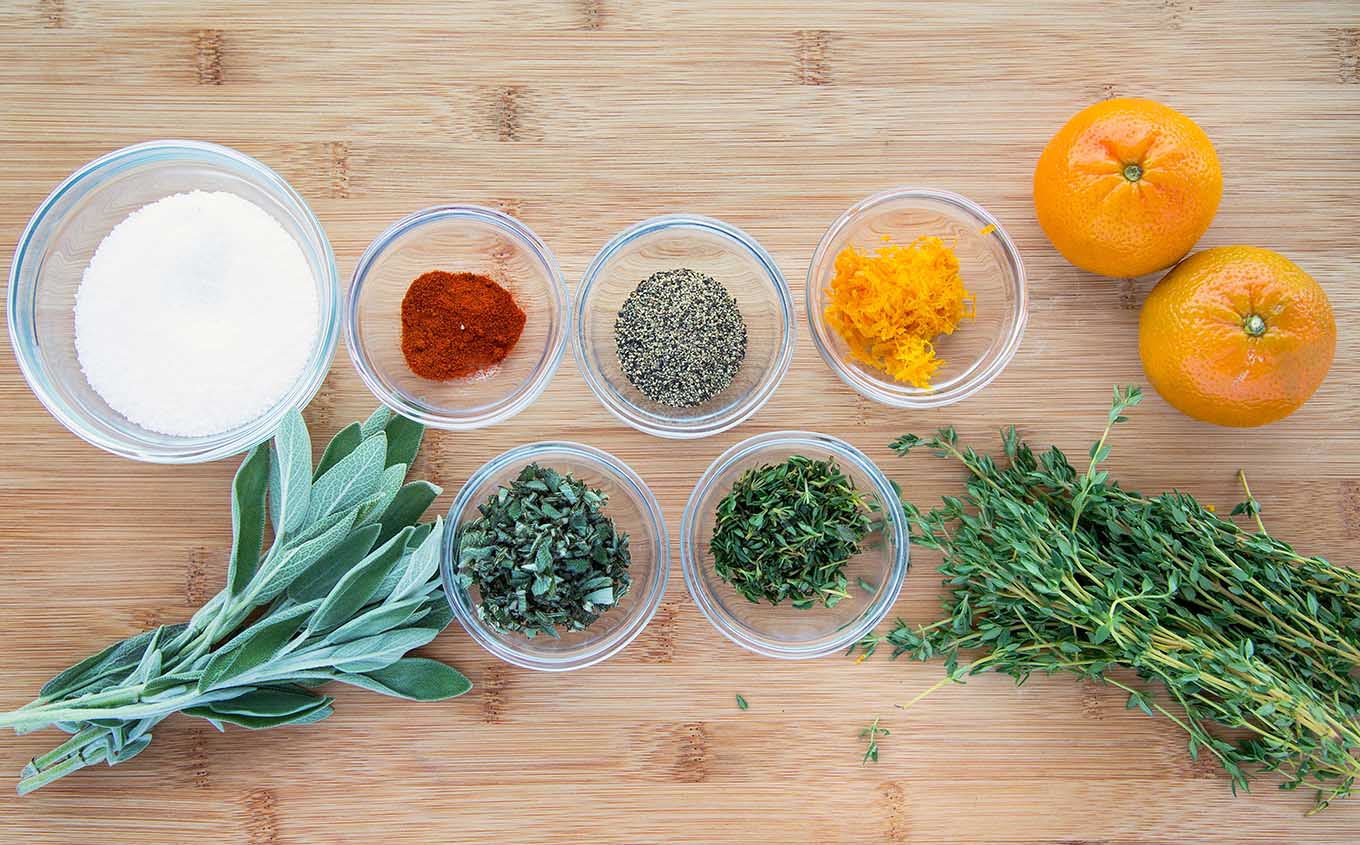
Let’s start by gathering the ingredients we need to dry brine our turkey. In Chef Speak, this is called the Mise en Place, which translates into Everything in its Place.
Not only does setting your ingredients up ahead of time speed the cooking process, but it also helps ensure you have everything you need to make the dish.
- Kosher Salt
- Black Pepper
- Smoked paprika
- Citrus zest
- Fresh thyme
- Fresh Sage
Do I have to use specific herbs and spices to dry brine a turkey?
That’s a tricky question because if you want a traditional Thanksgiving turkey, the answer is yes.
But If you like specific flavorings and aren’t into traditional Thanksgiving flavors, then by all means, have fun substituting spices that you like.
Recipes should be used as guidelines, and in all honesty, the salt is the only ingredient you really need for dry brining; the rest are added for flavor.
Why Should I dry-brine my turkey?
When you’re dealing with a large piece of meat like a whole turkey, it’s easy to overcook it into a dry, flavorless disaster. Dry Brining gives the dry brine mixture time to penetrate into the meat.
Dry brining (dry rub) is a way to inject both flavor and moisture into a turkey, giving you a flavorful, moist, roasted turkey.
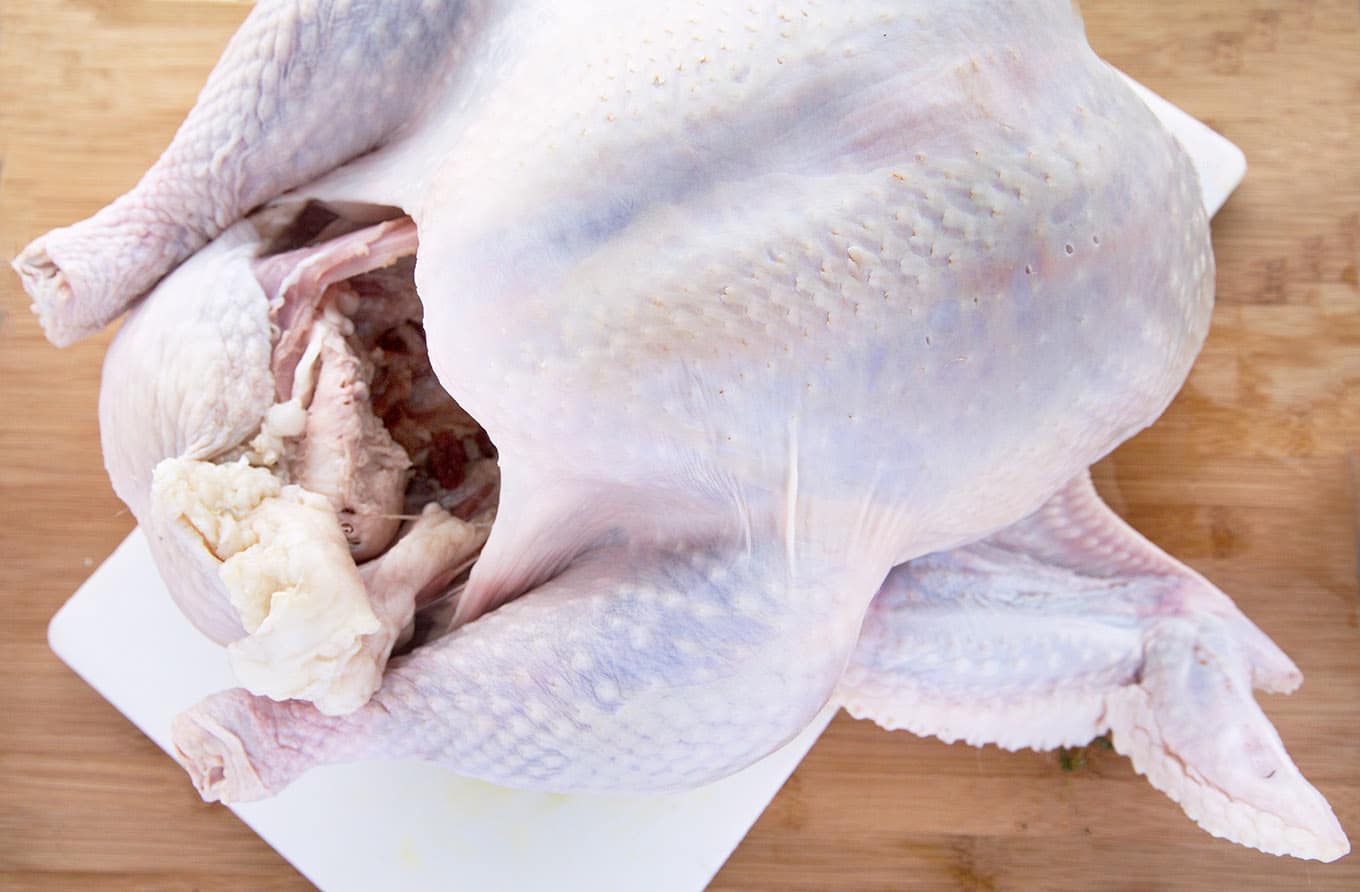
Rule #1 of Dry Brining
The larger the piece of meat, the more time is needed for the brine to be effective.
A dry brine, also called pre-salting, involves rubbing the salt, seasonings, and/or sugar directly onto the meat and skin and then letting the meat rest in the refrigerator for a period of time before cooking. During the process of dry brining, the salt draws out the juices through osmosis.
As the salt dissolves into the juices, it begins turning into a natural brine without any added liquid. This Natural brine is then reabsorbed into the meat and starts breaking down the tough muscle proteins. That is why this process needs up to 3 days to complete.
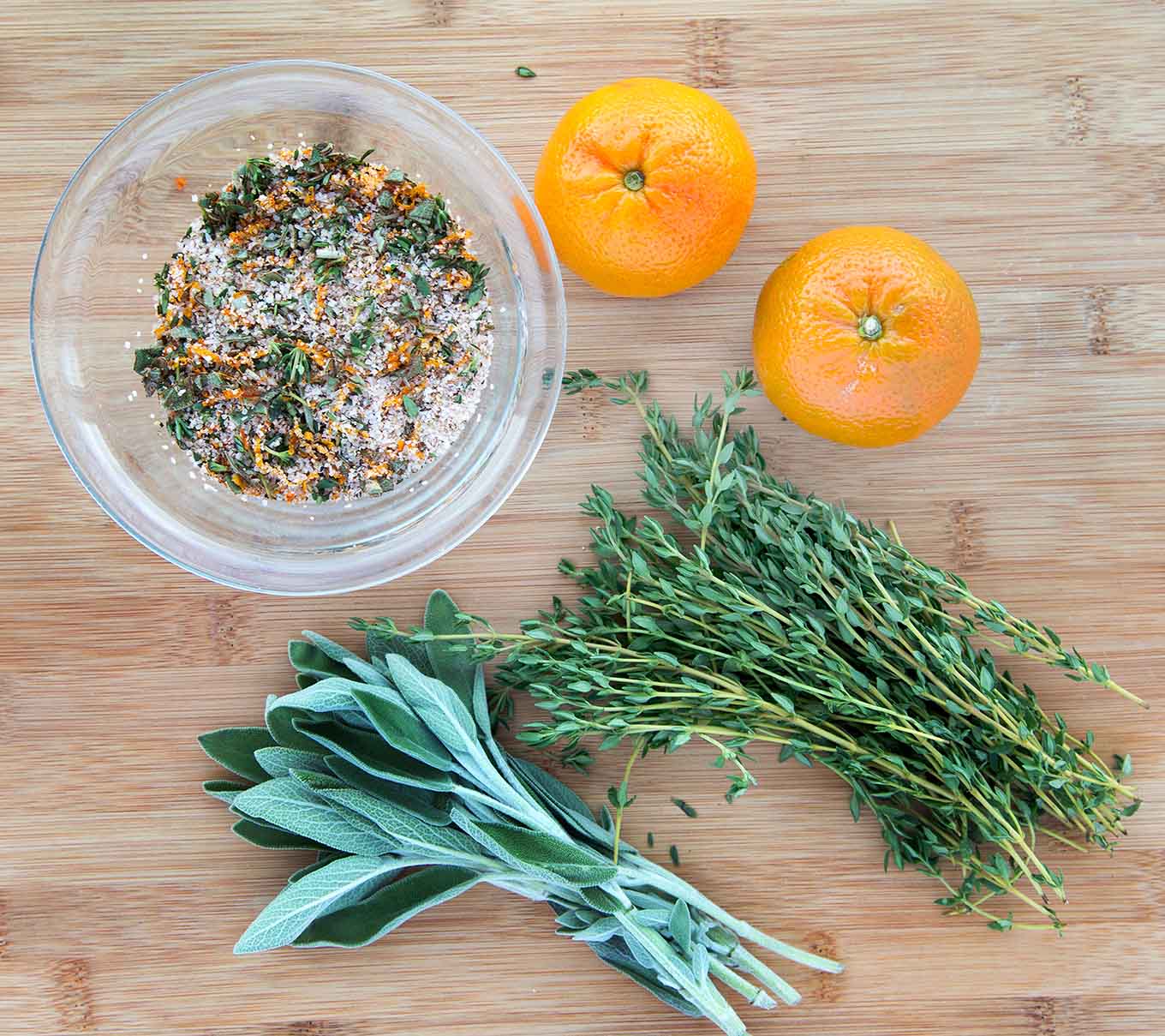
How to thaw a frozen turkey
The best way to thaw your turkey in the refrigerator in its original packaging. General defrosting times are 24 hours for every 4 pounds of Turkey.
If you have no choice and must thaw your turkey quickly, fill the kitchen sink with cold water and put the turkey in it, breast side down.
Make sure to completely submerge the turkey in water (in its original packaging) for the quick thaw method. Make sure to change the water every 30 minutes. This defrosting method will take 30 to 40 minutes per pound of turkey.
*When finished thawing the turkey, make sure to clean and disinfect the sink, spigots, and all surrounding surfaces.
*Don’t leave the turkey out to thaw on the countertop.
Chef Tips
- Don’t buy a preseasoned or kosher turkey (pre-salted) or self-basting turkeys. I always look for free-roaming or a heritage bird. But most importantly, no added salt.
- Make sure your turkey is thawed if you buy a frozen turkey. *Buy your turkey early enough so that it’s thawed and ready to brine on the Monday before Thanksgiving.
- It doesn’t have to be a whole turkey; you can dry brine a turkey breast.
- Getting under the skin of the turkey and applying the brine directly to the meat will make a tastier, moister turkey. If you’re only going to brine the skin, try and brine it for the full 72 hours.
- Don’t rush dry brining. To enjoy the best turkey you’ll ever have, you need to give it enough time to be effective. 2 days is the minimum, and can go as long as four days if you’re working with a 20-pound plus bird. *Any length of time you can brine the turkey is better than not brining the bird.
- You can use any herbs that you like, but the salt really does matter. Use Morton’s Kosher Salt for the best results. Diamond Kosher salt is a larger grain; if you use Diamond, increase the amount of salt by half. Don’t use table salt, it’s too fine and will make the turkey too salty.
- If you don’t have Kosher Salt, you can use Coarse Sea Salt or Coarse Himalayan Pink Salt because of the size of the coarse grains.
*The standard is one tablespoon of salt for every 5 pounds of turkey, but I like to go a little below that at one tablespoon of salt for every 6 lbs. So if you’re turkey is smaller, adjust the amount of salt and herbs.
Does it Matter Where I Apply the Mixture?
It does make a difference where you apply the dry brine. Separating the skin from the meat so that some of the dry brine can be rubbed directly on top of the meat (below the skin) will give you the best results.
If you apply the brine directly on the skin, it will need more time to penetrate the skin and get to the meat. The breast will also get more of the dry brine than the rest of the turkey. The turkey breast has the largest amount of meat on a conventional turkey.
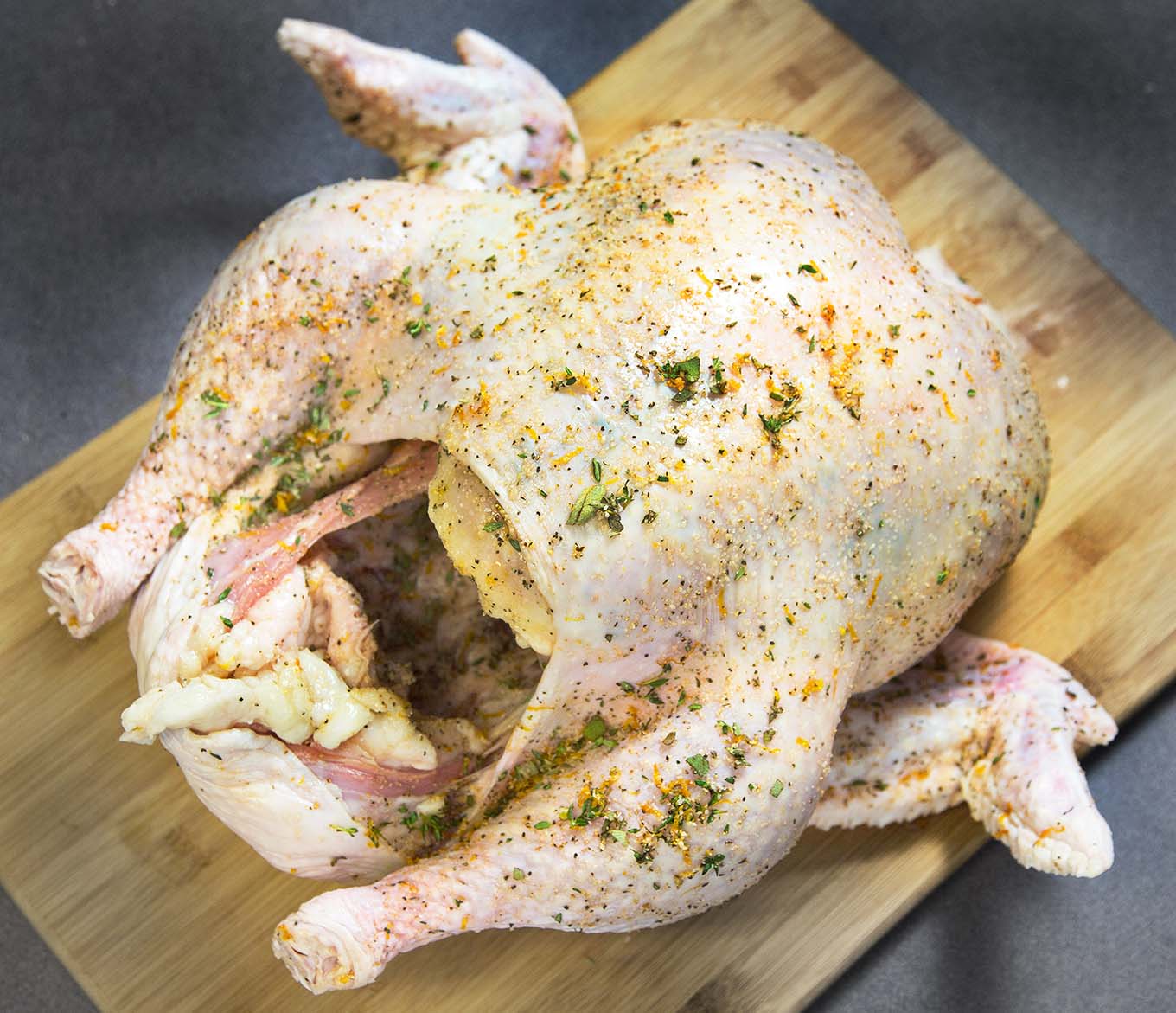
- After applying the dry brine, place the turkey breast side up in a roasting pan. Cover the turkey securely using plastic wrap. Or place it into a small plastic bag and seal it, removing as much of the air as possible. Refrigerate for 48 – 60 hours.
- Remove the plastic wrap and keep it refrigerated uncovered for the last 12 hours of brining. This will help crisp the turkey skin.
Can I use Dry Herbs?
Yes, you can, although I prefer fresh herbs. You can find them at most grocery stores in convenient little plastic containers. If fresh herbs are not available, by all means, use dry herbs. You can also add any other herbs or aromatics that you like.
Should I cook a Heritage Turkey Differently?
A heritage turkey is more elongated with drumsticks that are a good 1 to 2 inches longer than a modern bird, extending well beyond the tip of the breast.
Because of its more elongated shape, a heritage turkey cooks a little more quickly than a conventional turkey, so the biggest danger is overcooking. To make sure your Heritage Turkey is not overcooked, follow my recipe and change the cooking times.
Roast an unstuffed turkey at 425° for 20 minutes, then turn down the temperature to 325°F until the internal temperature of the thigh meat reaches 155°F.
Cooking 15-20 minutes per pound for the total cooking time. That being said, I would start checking the internal temperature 2 hours after the second phase of the process using an Insta-read thermometer in the thigh.
Also, make sure to allow 1-½ lb. per person compared to about one lb. for a conventional turkey. As an example, expect a 12-lb. heritage turkey to feed about eight people. Also, keep in mind that you’ll have as much dark meat as light meat. A conventional turkey will have more white meat.
Chef Tips for Roasting
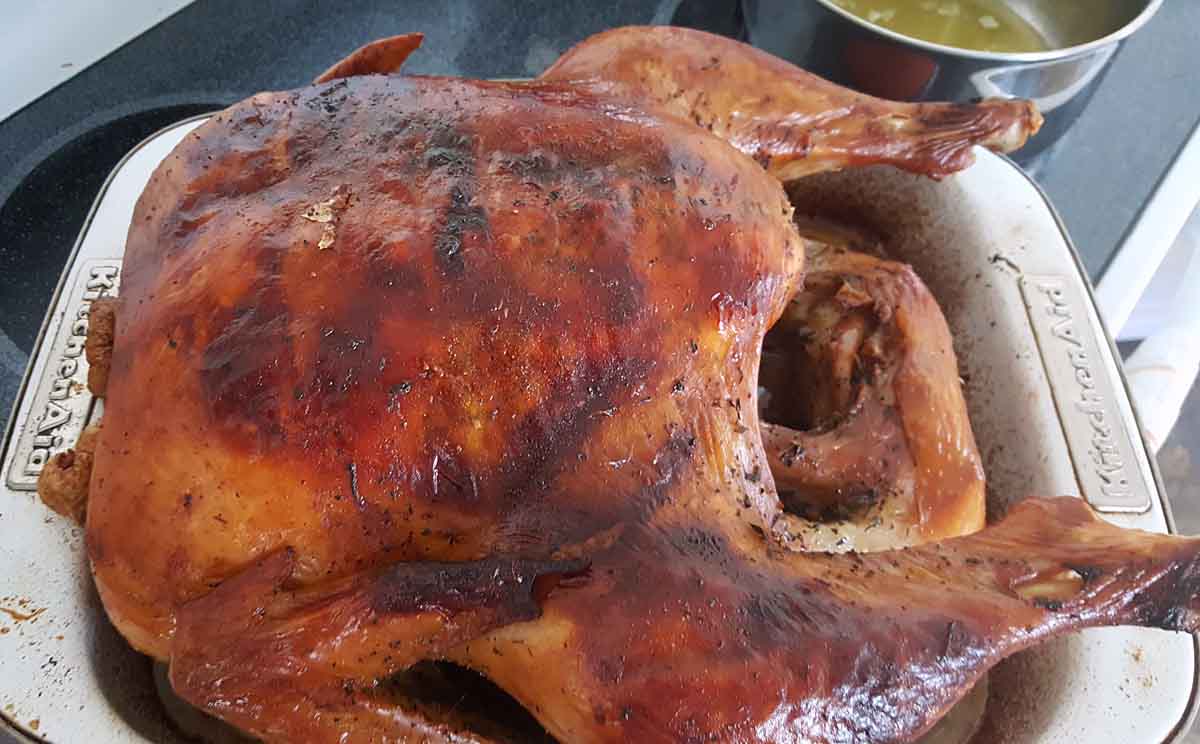
- Set your oven rack in the bottom third of the oven.
- Let the turkey sit out of refrigeration for about 30 minutes so it can come to room temperature before roasting.
- Allow the turkey to sit at room temperature for one hour before roasting. **Do Not Rinse The Brine Off Turkey
- Start off roasting the turkey at 425°F, and roast upside down for the first 45 minutes. At the end of that time, very carefully turn the turkey over with the breast side up to continue cooking.
- You’ll find that some ovens have cold spots. This is why it’s a good idea to rotate the turkey halfway through and baste for even cooking and browning. Keep some turkey or chicken stock handy in case your turkey doesn’t produce enough juice during the roasting process, and use that for basting if necessary.
- Always use an instant-read thermometer to ensure that your turkey has been cooked properly. Insert the thermometer into the thickest part of a thigh without touching the bone registers. Your turkey will be done when the thermometer reaches 165°F. It will continue to cook once you remove it from the oven, increasing by another 10 degrees.
- Let the turkey rest for 20-30 minutes before carving.
I absolutely love my Meater Plus | Smart Meat Thermometer. It takes all the guesswork out of cooking meats in the oven, on the grill, or in a smoker.
Do I have to start the turkey upside down?
No, you don’t. Safety should always come first and if you don’t think you can flip the turkey safely, skip that step. Still use the instruction for roasting starting at 425 degrees, then lowering to 325 degrees.
**If you do flip the turkey, take the pan out of the oven first. Don’t attempt this while the pan is in the oven.
You might also find heat-resistant gloves a good option. They’ll come in handy throughout the year.
Can I still Dry-Brine a Self-Basting or Kosher Turkey?
No, you can’t. That will make the turkey too salty! What you can do, is leave the salt out of the dry-brine ingredients and use the remainder of the seasonings as a dry rub. Feel free to add in your favorite spices.
Apply the dry rub for 24-36 hours and follow the roasting instructions.
My Turkey has been injected with a saline solution can I still use a dry brine?
While it’s not a good idea to add more salt to an injected turkey, you can still use the dry brine method. If your turkey is in the 15-pound range cut the Kosher Salt down to 1 Tablespoon. If your turkey is under 15 pounds reduce the salt accordingly. You can use the rest of the ingredients as stated in the recipe.
Why shouldn’t I stuff my turkey?
I know that the stuffing from inside the turkey is the best you’ll ever have. But it’s not a practice I recommend for two very important reasons.
The stuffing sucks a lot of the moisture (and flavor) out of the turkey. That’s why a stuffed turkey is often dry and overcooked. And the really bad news is, it puts us at risk for foodborne illness.
The longer it takes the turkey to reach an internal temperature of 165 degrees gives bacteria more time to multiply. And that means that uncle Sal (salmonella) might be paying you and your guests an unexpected holiday visit, which will definitely put a damper on the festivities.
**Stuffed turkeys also take longer to cook.
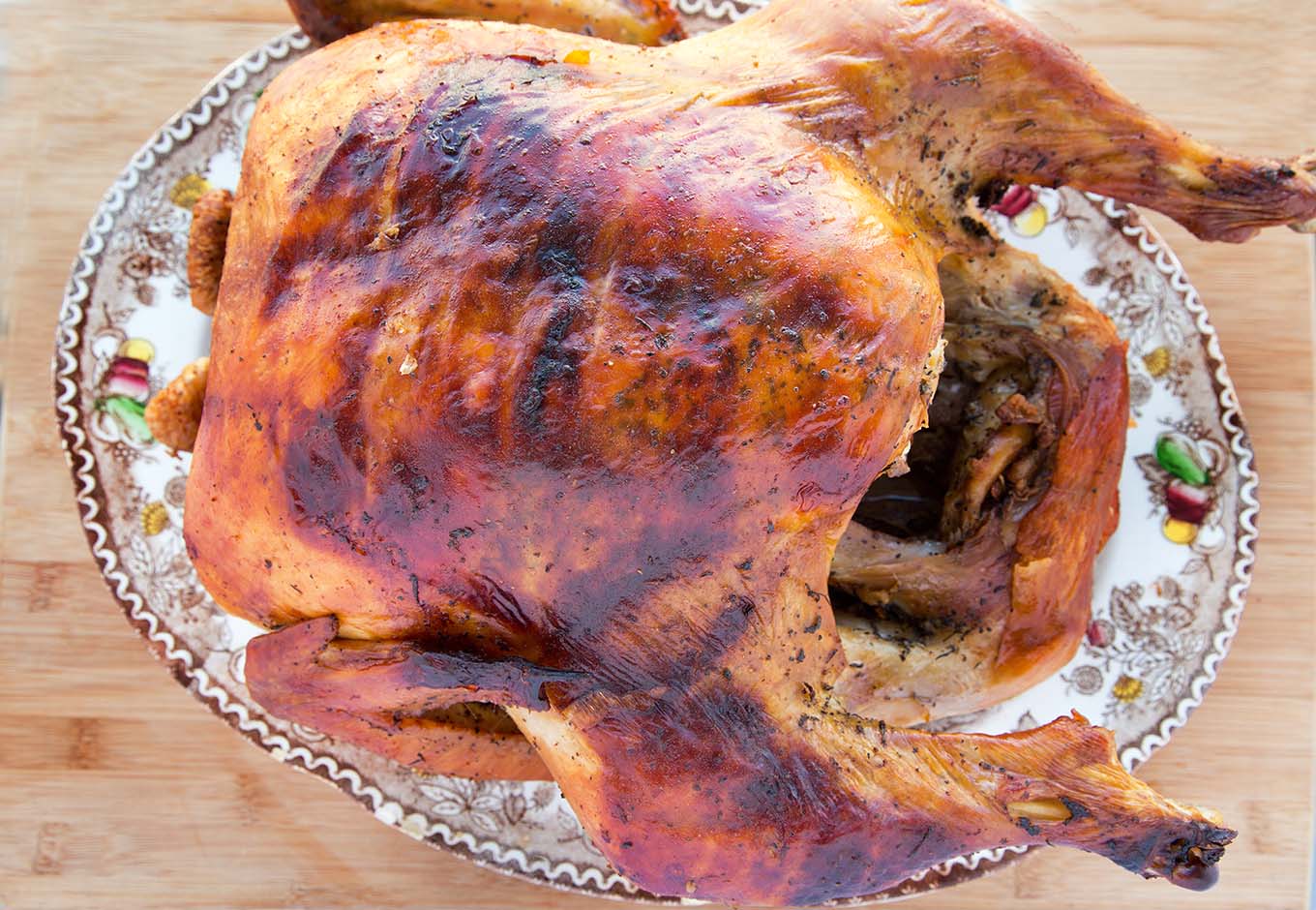
If you have leftover turkey, try my Old Fashioned Turkey Croquettes.
If you’re looking for a new Chef Knife, check out Misen. I’ve been using their kitchen knives for years!
Recipe FAQs
Dry-brining, also referred to as salting, is the process of rubbing the meat down with salt. The natural moisture content of the meat creates a concentrated brine that is naturally absorbed back into the meat before cooking.
A whole turkey needs two to three days of brining time. The dry-brining can be done days before Thanksgiving, giving you extra time on Turkey Day.
For the last 24 hours of the dry brine, leave the turkey uncovered in the refrigerator. This will dry out the skin, which in turn gives you incredibly crispy, golden-brown skin on the finished turkey.

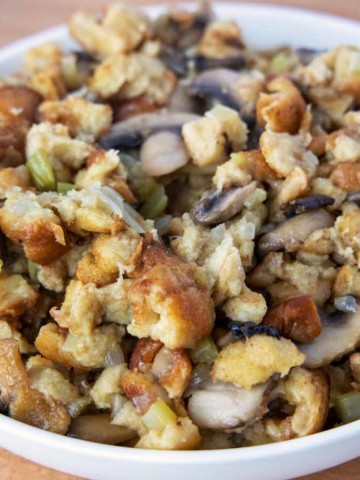
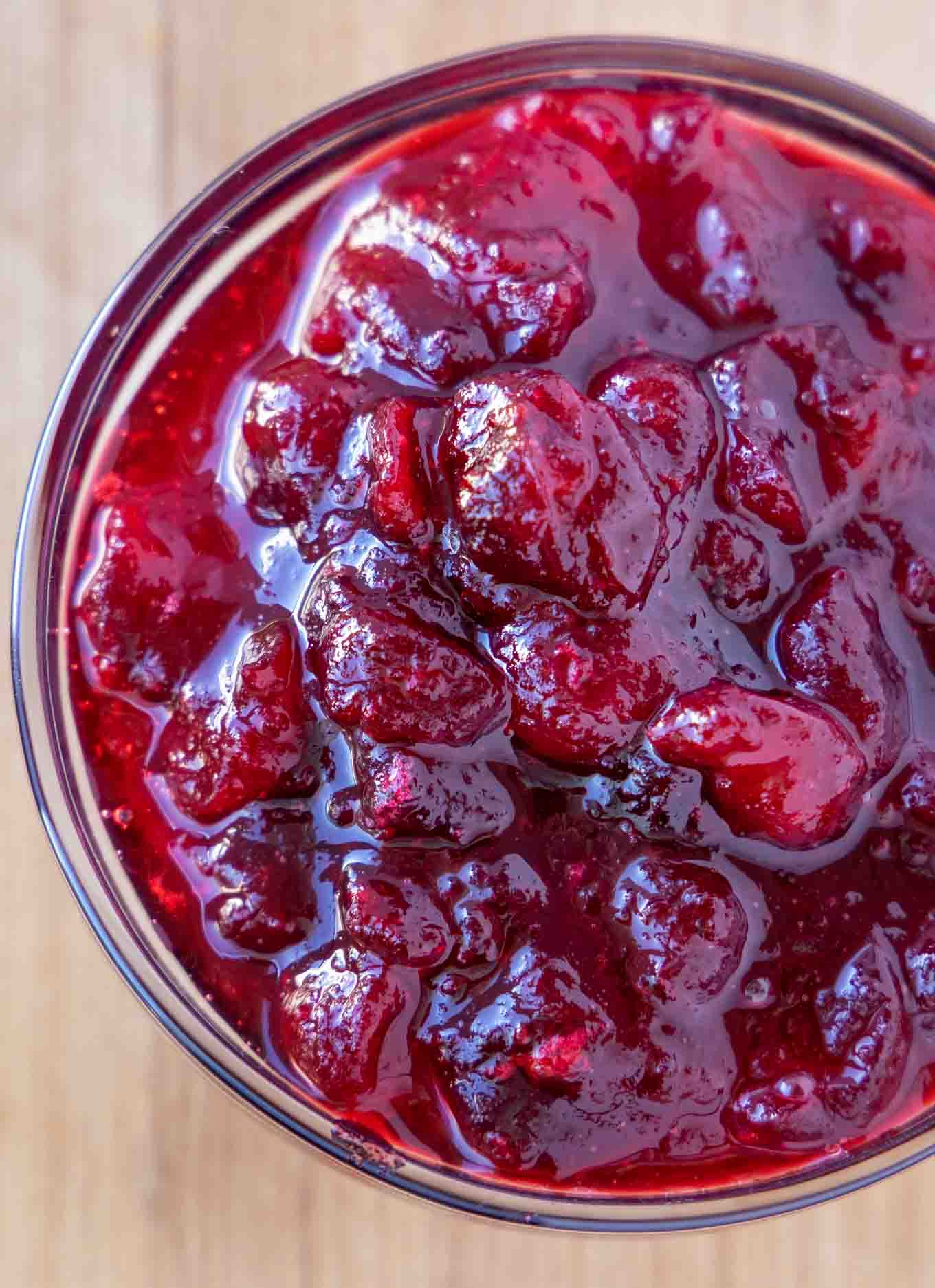
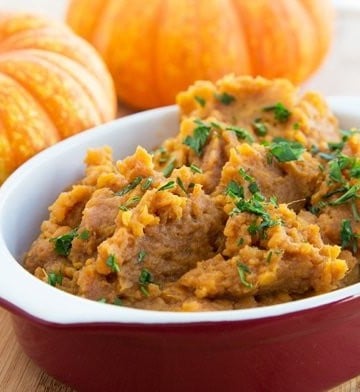
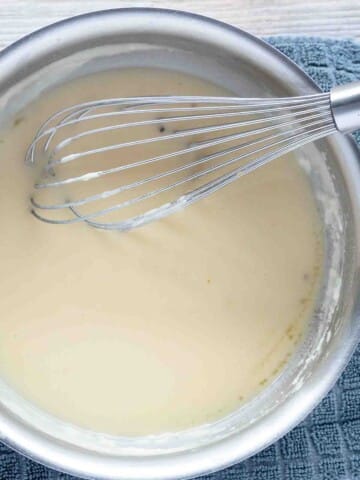
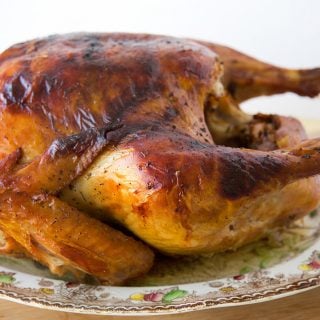
Steve V says
Happy Thanksgiving Chef Dennis,
I only have 1 oven, so I use a turkey roaster. Should I still roast upside down for the first 45 minutes?
Chef Dennis Littley says
If its possible for you to do it without getting burned, then I would definitely do it. If its going to be difficult, you don’t have too. If you don’t you can brush the breast with melted butter a few times during the process.
Nidia says
I used the dry brine recipe last year with my turkey and it made such a difference! The turkey was moist and had a great flavor. This year I am making a turkey breast. Will cut the brine recipe by 1/3 as noted. My question: do I still brine the turkey breast for the same amount of time as I would a regular turkey? Thank you!
Chef Dennis Littley says
You can cut the brining down to two days. I would also suggest during the roasting process, brushing the breast with butter every 30 minutes. Make sure to use a meat thermometer to make sure it reaches an internal temperature of 165 degrees F. If the skin is loose try and get some of the brine under the turkey skin.
Judi Jones says
If you don’t put the stuffing inside the turkey, how do you cook it?
Chef Dennis Littley says
Place the stuffing into your baking dish or casserole. Cover with non-stick foil and bake at 350 degrees for 75-90 minutes. If you want a crispy top, uncover the stuffing for the last 10 minutes of baking.
You don’t want the stuffing to be too thin, it should be 2+ inches thick.
James N. says
Hi Chef Dennis! Thanks for returning every year to educate the masses. I’ve used your dry brine for the last 10 years on 24lb turkeys and will never do anything different.
However, not stuffing the turkey for the family would be like getting a Ficus for a Christmas tree…I’d surely be burned as a heretic.
Also, flipping a hot bird that size, was a train wreck, so it now stays where it first lays.
I do have a few questions this year, when you have a moment…
1. I noticed that you now recommend plastic on the bird, instead of leaving uncovered for 3 days to dry the skin. Did something change?
2. I usually do a 375 degree oven throughout, as 425/325 seemed to take forever and risk drying out. Any thoughts on that lower temperature?
3. I have an oven with steam bake and steam roast capabilities…great for bread making. Have you ever tried that moister environment with a turkey?
Thanks!
Chef Dennis Littley says
You definitely don’t want to flip a bird that size, and I understand about stuffing the turkey, it is the best stuffing ever. Getting sick f I have not used the steam roast, but I would give it a try, it should help keep it moist. As for wrapping it in plastic, most people are worried about leaving it uncovered that long, but you can leave it uncovered for the whole time if you prefer.
The temperature you’re using is fine, you do have to make adjustments for a larger bird. You could use my mthod but its going to extend the cooking time. I would use your instincts on roasting, they seem to be working for you.
Jim D says
Hello Chef Dennis, this looks like a winner to me. I dry brine much of the meat (chicken, pork, beef) that we eat when I think ahead. I always seem to get good results. A 12-14lb turkey would be the largest dry brine and cook for me. I have never wrapped the meat while dry brining. I have used cheese cloth on large (8-10lb) beef rib roasts when brining for over 7 days. Supposed to lessen the meat desiccation. Why do you recommend covering first? And, I usually cook with convection heat. What temp. would you recommend?
Tricia says
We love turkey and don’t wait until the Holidays to have it. This dry brine recipe is great! It produces a very tasty bird, with fantastic leftovers. We usually use a smaller 12-pound bird and adjust the seasoning per the instructions. Rather than roast it whole, we do spatchcock it and reduce the cooking time. Turns out very moist, even the breast!
Chef Dennis Littley says
I’m happy to hear you enjoyed my dry brine. I’ve been using it on my turkeys for decades!
Dan says
I will be updating this after the cook is finished, but I did have a question about the roasting pan and gravy. My sense is that we are going to strain off the veggies etc. and then use it to deglaze and make a standard gravy. Also I assume that you are not trussing the turkey because of the roasting procedure? For sure adding dressing into the cavity will increase the roasting time but it also introduces the risk of drying things out!
Chef Dennis Littley says
That is correct strain the juices and use them for the gravy. There is no need to truss the turkey since its unstuffed. Stuffing a turkey draws moisture out of the turkey into the stuffing, which is why the dressing tastes so good, but it leaves the turkey dried out. It also can cause foodborne illness.
Dan says
Thanks for the reply; the 12 lb bird turned out great. Super moist and tasty. `Grandma’s gravy’ (a family tradition) also turned out fabulous too!
Chef Dennis Littley says
Thanks for letting me know you enjoyed the turkey!
Anita says
Thank you so much for sharing your turkey recipes. My son and I roasted two turkey breasts, using your recipe for the dry brine. We never had a better Thanksgiving turkey before. It was so moist, tender and delicious!
Jen says
Hi Chef Dennis. Long time fan of your tiramisu here. I am so grateful for your site with clear and helpful instructions. I hope I can get a response in time and if not maybe the answer will help someone else. I’ve got someone coming over for Thanksgiving who can’t have dairy. What can I use instead of butter? A certain oil? Schmaltz? Thanks in advance.
Chef Dennis Littley says
You can use olive oil or Smart Balance makes an excellent non dairy butter. Either of those would be good replacements.
Jen says
It came out great. Thank you so much!
Chef Dennis Littley says
You’re very welcome! I’m happy to hear you enjoyed the turkey.
Julia says
Hopefully this helps you! I have a kid with a severe, life threatening dairy allergy, and I use Imperial brand margarine for my cooking and baking. It tastes good, works well, and has no milk, lactose, whey, or casein. In other words, completely dairy free (not all margarine brands are, some contain dairy products). Happy Thanksgiving! Thanks for making food that your friend can eat, food allergies can be very isolating especially when they’re severe.
Jen says
Thank you for these tips.
Dan Bank says
quick question:
should I use the convection setting on my oven?
Chef Dennis Littley says
Yes, that will help the turkey cook more quickly and evenly.
Earnest Cave says
Can I smoke this Dry Brined turkey in the smoker?
Ramona says
I am making this as I speak, it smells wonderful. My chicken is a larger one, it is a 2.5 kgs – how long do you think I should be cooking it for? Thanks
Chef Dennis Littley says
It will take between 1.5 -2 hours for the chicken. It’s best to use an instant read thermometer to make sure its cooked to the proper temperature.
Sheila says
Can I use your dry brine method, but cook the turkey in an oil-less outdoor fryer?
Chef Dennis Littley says
Yes you can cook it that way.
Michael says
The five stars is a late thank you for absolutely the very best Tiramisu…nothing can compare!
My turkey question: With the dry rub for a 12 lb turkey that has been spatchcocked, what would be your suggested cooking temperature(s) and estimates for cooking time?
Thanks for your help
Chef Dennis Littley says
Cooking temp is 425 and it will take about 90 minutes to cook. Make sure to use an instant read thermometer to check the temperature is at least 165 degrees when finished cooking.
Lona Ruhr says
Hi Chef Dennis, I previously sent a message but not sure it went through. First of all, We have used your Dry Brine Prime Rib Recipe the last 2 years. This is the best recipe ever. Beats any Prime Rib we have ever had. It’s Fantastic. I Need your help. We have a 23 lb. Turkey. We want to use your Dry Brine Recipe. But this means our turkey will have to be refrigerated for 8-9 days. The FDA says once thawed it should only be in the refrigerator only 1-2 days after it’s thawed? Should we take the turkey out of the freezer and wait a couple days to brine it, so that it’s only out for 5-6 days? We really want to use your recipe after we’ve tried your prime rib recipe. Help Us Please… Thanks So Very Much. Lona
Chef Dennis Littley says
Hi Lona
The turkey has to be fully thawed before brining, and the days it’s frozen don’t count towards the number of days it’s kept in the refrigerator. I would start the dry brine at the beginning of day 5 (it should be pretty well thawed by then), then let it sit with the brine for the remaining 3-4 days.
As long as it’s kept in the coldest part of the refrigerator, you’ll be fine. I always brine for 3-4 days after thawing.
With the size of that bird, I wouldn’t recommend flipping it as I do in my recipe; that’s just too big to attempt. So cook it breast-side up, brushing the breast with butter every 90 minutes.
I’m happy to hear you enjoyed my prime rib recipe. Let me know how the turkey turns out.
yana says
This is the first time in many years that my Turkey was perfect.
THANK YOU
Chef Dennis Littley says
I am thrilled to hear that you enjoyed my turkey recipe and that your turkey turned out so well! I hope you find more recipes on my blog to try.
Tracy says
What if I can only find a kosher turkey? Can I still use it but should I just reduce the amount of salt in the brine or omit it entirely? Thanks!
Chef Dennis Littley says
You can still use the dry brine, but I would eliminate the salt and just make it out of herbs and seasonings. You also won’t need to let it brine for more than 24 ours.
Gaby says
Hello Chef, Thank you so much for your detailed and helpful instructions. I followed your recipe exactly today after 3-days dry-brine (an early-Christmas season turkey dinner with friends), and the turkey was tender and flavourful, and the drippings were not too salty. I used no-salt broth at the bottom, and used no-salt butter to brush the turkey. I feel proud of the turkey and the gravy I made with the drippings. Thank you! I will make your recipe again.